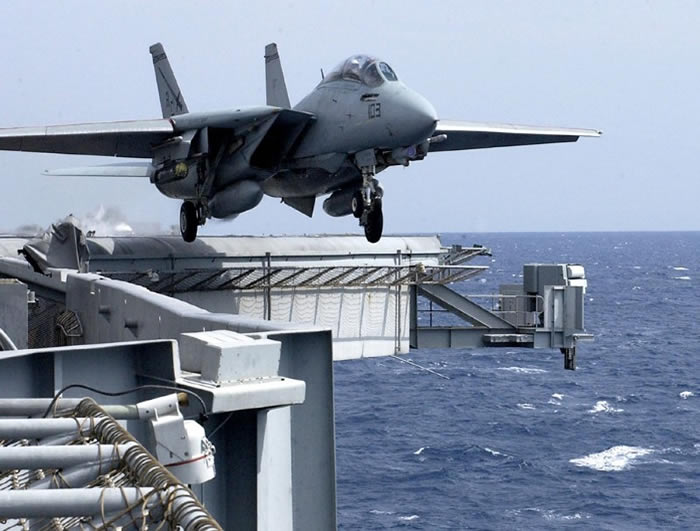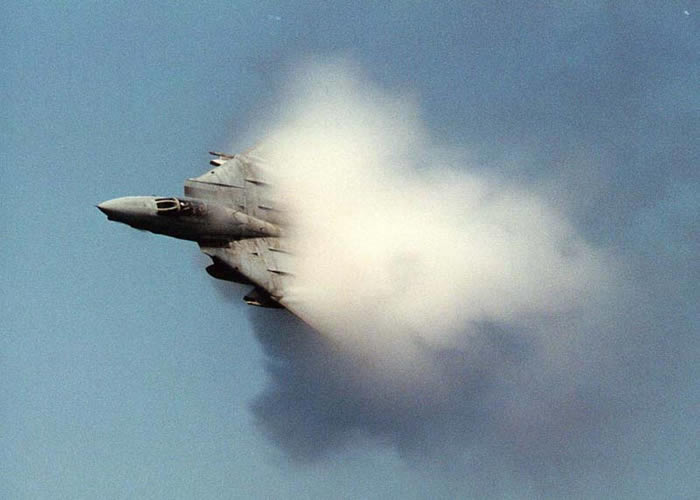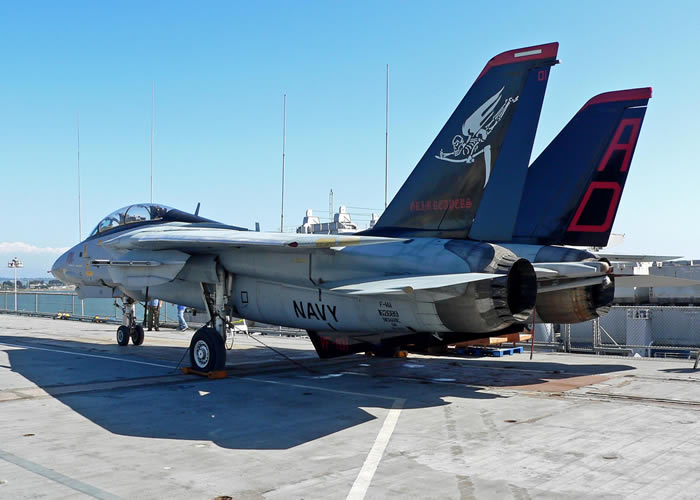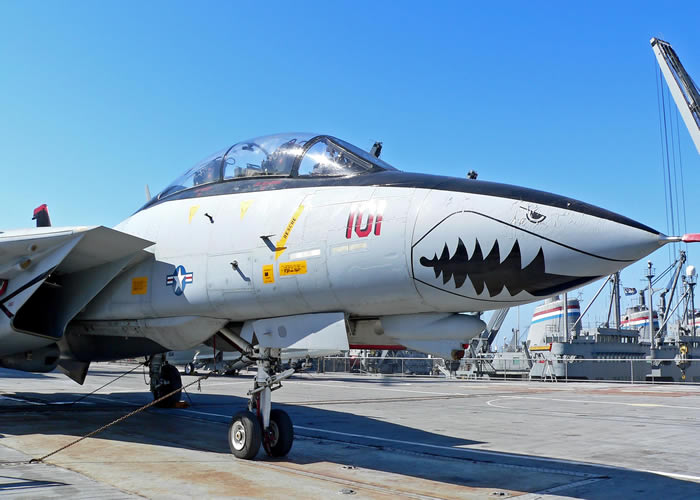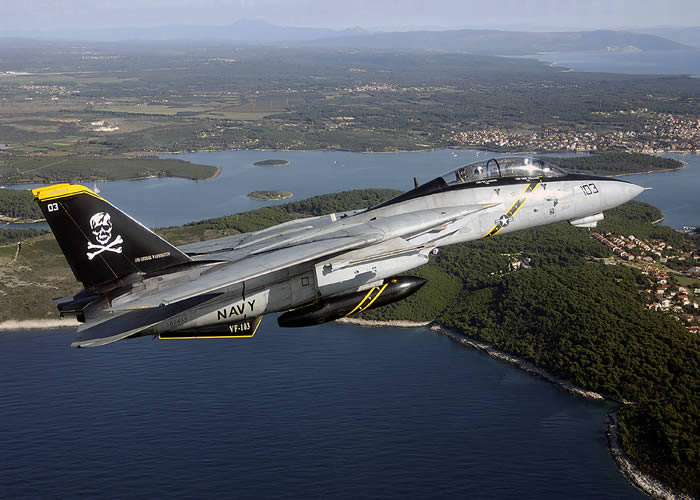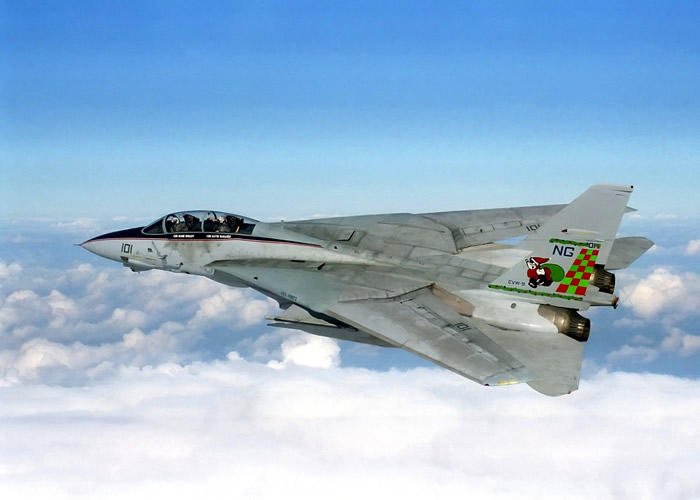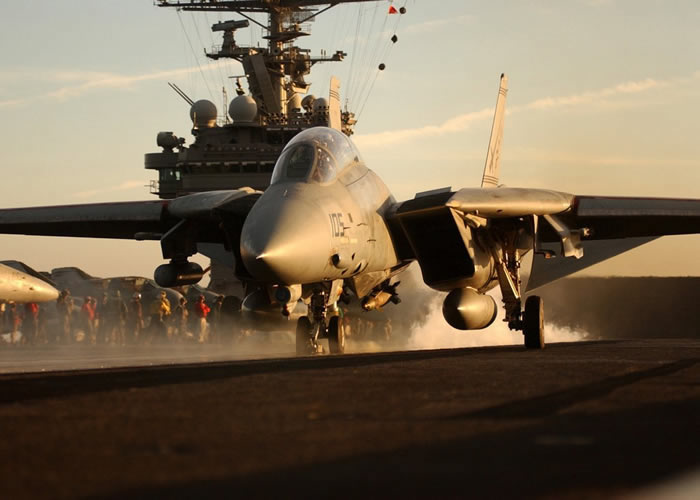US NAVY GRUMMAN F-14 (TOP GUN AIRCRAFT) TOMCAT FIGHTER
INTERCEPTOR INFORMATION PICTURES HISTORY AND FACTS
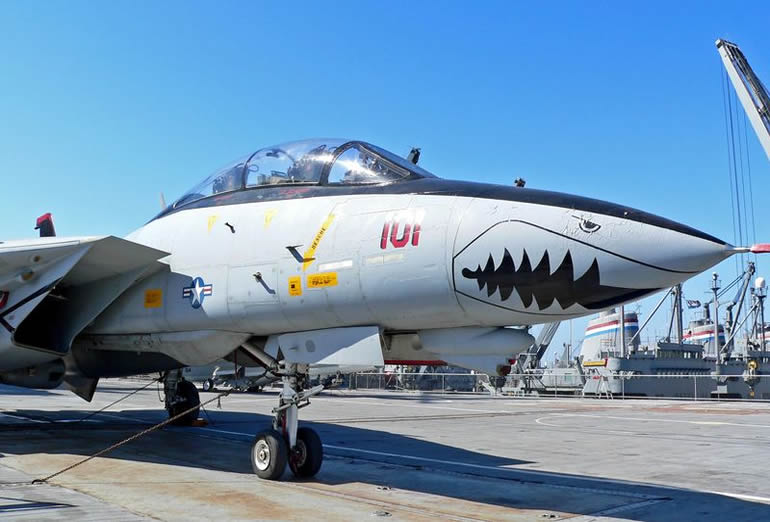 |
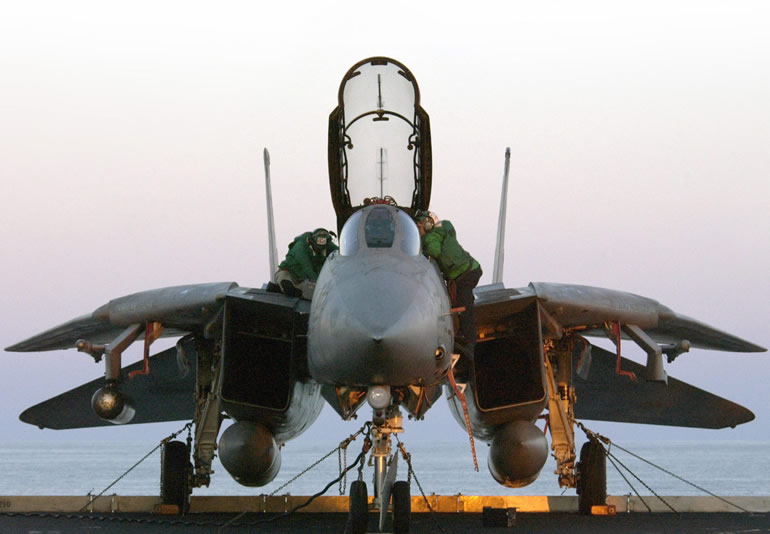 |
The Grumman F-14 Tomcat is a supersonic, twin-engine, two-seat, variable geometry wing aircraft.The F-14 was the United States Navy's primary maritime air superiority fighter, fleet defense interceptor and tactical reconnaissance platform from 1974 to 2006. It later performed precision strike missions once it was integrated with the Low Altitude Navigation and Targeting Infrared for Night LANTIRN system. The F-14 was developed after the collapse of the F-111B project, and was the first of the American teen-series fighters which were designed incorporating the experience of air combat in Vietnam against MiGs.
It entered service in 1972 with the U.S. Navy, replacing the F-4 Phantom II. It was later exported to the former Imperial Iranian Air Force in 1976, during a time when the US still had good relations with Iran. It was retired from the active U.S. Navy fleet on 22 September 2006, having been replaced by the F/A-18E/F Super Hornet. As of 2008, it remains in service only with the Islamic Republic of Iran Air Force. Development
The Naval Air Systems Command (NAVAIR) shortly issued an RFP for the Naval Fighter Experimental (VFX), a tandem two-seat fighter with maximum speed of Mach 2.2 and a secondary close air support role. Of the five companies that submitted bids (four of which incorporated variable-geometry wings as on the F-111), McDonnell Douglas and Grumman were selected as finalists in December 1968, and Grumman won the contract in January 1969. Grumman had been a partner on the F-111B, and had started work on an alternative when they saw the project heading south, and so had an edge on its competitors. Their early design mock-ups and cost projections were floated among Navy brass as an alternative to the F-111B. The winning Grumman design reused the TF30 engines from the F-111B, though the Navy planned on replacing them with the F401-PW-400 engines then under development by Pratt and Whitney for the Navy (in parallel with the related F100 for the USAF). Though lighter than the F-111B, it was still the largest and heaviest U.S. fighter to ever fly from an aircraft carrier, its size a consequence of the requirement to carry the large AWG-9 radar and AIM-54 Phoenix missiles, also from the F-111B and an internal fuel load of 16,000 lbs (7,300 kg). The F-14 would also share a similar inlet duct, wing, and landing gear geometry with Grumman's A-6 Intruder.
Upon being granted the contract for the F-14, Grumman greatly expanded its Calverton, Long Island, New York facility to test and evaluate the new swing-wing interceptor. Much of the testing was in the air of the Long Island Sound as well as the first few in-flight mishaps, including the first of many compressor stalls and ejections. In order to save time and forestall interference from Secretary McNamara, the Navy skipped the prototype phase and jumped directly to full-scale development; the Air Force took a similar approach with its F-15. The F-14 first flew on 21 December 1970, just 22 months after Grumman was awarded the contract, and reached Initial Operational Capability (IOC) in 1973. The Marine Corps was initially interested in the F-14 as an F-4 replacement and went so far as to send pilots and radar intercept officers to Fighter Squadron One Twenty-Four (VF-124), the Pacific Fleet Replacement Squadron for the F-14, to train as instructors. But the Marine Corps was never fully sold on the aircraft and pulled out when the stores management system for ground attack munitions was left undeveloped, leaving the aircraft incapable of dropping air-to-ground munitions (these were later developed in the 1990s).
Improvements and changes With time, the early versions of all the missiles were replaced by more advanced versions, especially with the move to full solid-state electronics that allowed better reliability, better ECCM and more space for the rocket engine. So the early arrangement of the AIM-54A Phoenix active-radar air-to-air missile, the AIM-7E-2 Sparrow Semi-active radar homing air-to-air missile, and the AIM-9J Sidewinder heat-seeking air-to-air missile was replaced in the 1980s with the B (1983) and C (1986) version of the Phoenix, the F (1977), M (1982), P (1987 or later) for Sparrows, and with the Sidewinder, L (1979) and M (1982). Within these versions there are several improved batches (for example, Phoenix AIM-54C++).
The Tactical Airborne Reconnaissance Pod System (TARPS) was developed in the late 1970s for the Tomcat. The TARPS reconnaissance pod was carried on the right rear fuselage tunnel station and required additional connections. Approximately 65 F-14As and all F-14Ds were modified to carry the pod. The system was primarily controlled by the RIO in the back seat who had a specialized TARPS display to observe reconnaissance data. TARPS system was introduced in 1980. The TARPS was upgraded with digital camera in 1996 with the "TARPS Digital (TARPS-DI)". The digital camera was further updated beginning in 1998 with the "TARPS-CD" configuration. Adding ground attack capability
By 1994 Grumman and the Navy were proposing ambitious plans for Tomcat upgrades to plug that gap between the retirement of the A-6 and F/A-18E/F Super Hornet entering service, but Congress balked. The upgrades were priced in the billions, a bit much for an interim solution, and they would take too long to implement to meet the gap. The solution finally devised was an inexpensive and quick upgrade, with fit of the Low Altitude Navigation and Targeting Infrared for Night (LANTIRN) targeting pod system that provided the F-14 with a forward-looking infrared (FLIR) camera for night operations and a laser target designator to direct laser guided bombs (LGB). Although LANTIRN is traditionally a two-pod system, with an AN/AAQ-13 navigation pod with terrain-following radar and a wide-angle FLIR, along with an AN/AAQ-14 targeting pod with a steerable FLIR and a laser target designator, the decision was made to only use the targeting pod. The Tomcat's LANTIRN targeting pod featured some improvements over its baseline configuration, most significantly a Global Positioning System / Inertial Navigation System (GPS-INS) capability that allowed a Tomcat to find its own location at any time. The pod was carried on the right wing glove pylon.
An F-14D from VF-31, makes a transonic, low-level fly-by with LANTIRN pod on starboard glovevane station.Fit of the LANTIRN pod didn't require any updates to the F-14's own system software, which would have substantially increased the time and expense of the upgrade. It did require that the Tomcat have the MIL-STD-1553B bus, fitted standard to the F-14D and on upgraded F-14A/Bs. The RIO received pod imagery on his display and guided LGBs using a new hand controller. Initially the hand controller replaced the RIO's TARPS control panel, meaning a Tomcat configured for LANTIRN couldn't carry TARPS and the reverse, but eventually a workaround was developed that allowed a Tomcat to carry LANTIRN or TARPS as needed. An upgraded LANTIRN named "LANTIRN 40K" with 40K laser allowing improved operation up to 40,000 feet (12,200 m) was introduced into service in 2001. Tomcats also added the ability to carry the GBU-38 Joint Direct Attack Munition (JDAM), giving it the option of a variety of LGB and GPS-guided weapons. Further improvements The latest upgrade to the Tomcat included the Link 16 software which enables the aircraft to target enemy aircraft spotted by AWACS aircraft without using its own radar, giving it superior look down kill ability in BVR combat scenarios. Overview Fuselage and wings The F-14's wing sweep can be varied between 20° and 68° in flight, and is automatically controlled by an air data computer. This maintains the wing sweep to give the optimum lift-to-drag ratio as the Mach number varies, but the system can be manually overridden by the pilot if necessary. When the aircraft is parked, the wings can be "overswept" to 75°, where they overlap the tail to save space on tight carrier decks. In an emergency, the F-14 can land with the wings fully swept to 68°, although this is far from optimum and presents a significant safety hazard. The F-14 can also fly and land safely with the wings swept asymmetrically, in emergencies. The wings have a two-spar structure with integral fuel tanks. Much of the structure, including the wing box, wing pivots and upper and lower wing skins is made of titanium, a light, rigid and strong material, but also difficult to weld, and costly. Ailerons are not fitted, with roll control being provided by wing mounted spoilers at low speed (which are disabled if the sweep angle exceeds 57°), and by differential operation of the all-moving tailerons at high speed.[8] Full-span slats and flaps are used to increase lift both for landing and combat, with slats being set at 17° for landing and 7° for combat, while flaps are set at 35° for landing and 10° for combat. The twin tail layout helps in maneuvers at high AoA (angle of attack) while reducing the height of the aircraft to fit within the limited roof clearance of hangars aboard aircraft carriers. Two under-engine mount points are provided for external fuel tanks. Two retractable surfaces, called glove vanes, were originally mounted in the forward part of the wing glove, and could be automatically extended by the flight control system at high Mach numbers. They were used to generate additional lift ahead of the aircraft's center of gravity, thus helping to compensate for the nose-down pitching tendencies at supersonic speeds. Automatically deployed at above Mach 1.4, they allowed the F-14 to pull 7.5 g at Mach 2 and could be manually extended at above Mach 1. They were later disabled, however, owing to their additional weight and complexity. The airbrakes consist of top-and-bottom extendable surfaces at the rearmost portion of the fuselage, between the engine nacelles. The bottom surface is split into left and right halves, with the arrestor hook hanging between the two halves. This arrangement is sometimes called the "castor tail", or "beavertail." The Tomcat has fully mechanical flying controls, with the only exception being the spoilers, which are hydro-electrically driven. Engines and landing gear Both air intakes have movable ramps and bleed doors that are operated by the air data computer to enable enough air to enter the engine while keeping shockwaves away from the engine. The exhausts also feature variable nozzles with moving petals that open or close depending on engine state. The TF30 engines left much to be desired both in power and reliability. John Lehman, Secretary of the Navy, told Congress that the F-14/TF30 combination was "probably the worst engine/airframe mismatch we have had in years" and said that the TF30 was "a terrible engine", with F-14 accidents attributed to engine failures accounting for 28% of overall losses. Cracks in the turbines were dangerous to the point that the engine bay was reinforced in case of blade failure, to help reduce damage to the rest of the aircraft. The TF30 engines were also extremely prone to compressor stalls, which could easily result in loss of control due to the wide engine spacing, which causes severe yaw oscillations and can lead to an unrecoverable flat spin. At specific altitudes, the exhaust from a launched missile could cause the engine compressor to stall. This resulted in the development of a bleed system that temporarily reduced the power of the engine and blocked the frontal intake during missile launch. The overall thrust-to-weight ratio at maximum load is around 0.56, which does not compare favorably with the F-15A's ratio of 0.85. Even so, the aircraft itself is able to reach Mach 2.4, and the maximum speed is officially Mach 2.34. Internal fuel capacity is 2,400 US gallons (9100 L): 290 US gallons (1100 L) in each wing, 690 US gallons (2600 L) in a series of tanks aft of the cockpit, and a further 457 US gallons (1730 L) in two feeder tanks. The aircraft can carry two 269 US gallon (1020 L) external tanks under the nacelles. There is also an air-to-air refueling probe, which folds into the starboard nose. F-14 with landing gear deployed.The undercarriage is very robust, in order to withstand the harsh takeoffs and landings necessary for carrier operation. It comprises a double nose wheel and widely spaced single main wheels. The result is very different from the narrow and high undercarriage of F-15 Eagle. Both have similar weights and a high wing that makes undercarriage stowage impractical. The Tomcat fuselage is wider and the aircraft does not need to hold big external fuel tanks, as the Eagle often does, in the ventral positions. There are no hardpoints on the sweeping parts of the wings, and so all the armaments are fitted on the belly between the air intakes and on pylons under the wing gloves. Avionics and flight controls The nose of the aircraft is large because it carries not only the two person crew, but also a large number of avionics systems. The ECM and navigation suite are extremely comprehensive and complex. The main element is the Hughes AWG-9 X-band radar, which in the initial version included a lightweight 5400B digital system with 32 kilobytes of RAM. The antenna dish is a 36-inch (91 cm) wide planar array, uses 10 kW of power, and has integrated IFF antennas. There are available several search and tracking modes, such as Track-While-Scan (TWS), Range-While-Search (RWS), Pulse-Doppler Single-Target Track (PDSTT), Jam Angle Track (JAT). A maximum of 24 targets can be tracked simultaneously and six can be engaged in the mode "multiple" (TWS) up to around 60 miles (100 km). There is also a "single target" mode with a maximum range of around 96 statute miles (150 km). The maximum search range can exceed 120 statute miles (190 km) and even a fighter can be locked onto at around 72 - 90 statute miles (120–140 km). Cruise missiles are also possible targets with the AWG-9, since this radar can lock onto and track even small objects at low altitude with a Doppler filter. The radar antenna dish is in the nose, and most of the radar avionics are located just behind the nose, near the pilot's position. Other avionics (such as IFF, communication radios, direction-finding equipment, etc) are near the RIO's position, and are mostly integrated into the AWG-9 display system. Early Tomcats featured ECM and RWR systems, chaff launchers, fighter-to-fighter data link, and a precise inertial navigation system. The original set of sensors also comprised an infrared sensor under the nose in a "chin pod": it was AN/ALR-23 with indium antimonide detectors, cooled by a self-contained Stirling-cycle cryogenic system, but this proved ineffective, and was replaced with a new system. This was an optical system, Northrop AAX-1, also called TCS (TV Camera Set) and was used to help pilots visually identify and track aircraft, at least on day missions, up to a range of more than 60 miles for large aircraft (a zoom function was included to help with small fighters). The TCS could be "slaved" to the radar to follow whatever the radar is tracking, and the radar could be slaved to the TCS to track whatever the camera "sees." Both the crew have access to the images on their displays. Despite its utility, for a long time most F-14s did not have the system added. Bill Gunston reported that even in 1983 this lack meant that only one in eight aircraft had the system fitted. In every case, this system is the only one of its kind fielded by modern US fighters for air to air missions. A dual IR/TCS system was adopted for the later F-14D variant, with an ECM antenna fitted as well in the same mast. This meant Tomcats could be configured with only an ECM antenna, or the IR sensor, or TCS, or many combinations thereof. The Tomcat's ESM system consists of many subsystems: RWR, ECM, and chaff/flare dispensers in various parts of the fuselage, nose, tail and wings. This was a marked difference with many previous fighter aircraft in that some did not even include a simple RWR. Armament The theoretical maximum load of six Phoenix missiles was so heavy that such a combination was never used operationally. This meant the capability to engage six targets went unused, although early testing proved it was possible and the F-14 was never operationally required to engage six hostile targets simultaneously. Tomcats were rarely sent on patrol alone. Operational history United States Navy Despite the attention given to the Tomcat over aerial encounters in the Gulf of Sidra, its first sustained combat baptism of fire was as a photo reconnaissance platform. The Tomcat was selected to inherit the Reconnaissance mission upon departure of the dedicated RA-5C Vigilante and RF-8G Crusaders from the fleet. A large pod called the Tactical Airborne Reconnaissance Pod System (TARPS) was developed and fielded on the Tomcat in 1981. With the retirement of the last RF-8G Crusaders in 1982, TARPS F-14s became the U.S. Navy's primary tactical reconnaissance system. One of two Tomcat squadrons per airwing was designated as a TARPS unit and received 3 TARPS capable aircraft and training for 4 TARPS aircrews. An F-14A Tomcat from VF-114 intercepting a Soviet Tu-95RT "Bear-D" maritime patrol aircraft.While the Tomcat was being used in combat in its intended air superiority mission over the skies of Iran in the early 1980s, the US Navy found itself flying regular daily combat missions over Lebanon to photograph activity in the Bekaa Valley. At the time, the Tomcat had been thought too large and vulnerable to be used overland, but the need for imagery was so great that Tomcat aircrews developed high speed medium altitude tactics to deal with considerable AAA and SA-7 SAM threat in the Bekaa area. An urgent combat need was stated to address the Tomcat vulnerability in this type of mission. The first exposure of a Tomcat to a SA-2 was over Somalia in April 1983 when a local battery was unaware of two Tomcats scheduled for a TARPS missions in prelude to an upcoming international exercise in vicinity of Berbera. An SA-2 was fired at the second Tomcat while conducting 10 thousand foot mapping profile at max conserve setting. The Tomcat aircrews spotted the missile launch and dove for the deck thereby evading it without damage. The unexpected demand for combat TARPS laid the way for high altitude sensors such as the KA-93 36 in (91 cm) Long Range Optics (LOROP) to be rapidly procured for the Tomcat as well as an Expanded Chaff Adapter (ECA) to be incorporated in a AIM-54 Phoenix Rail. Commercial "Fuzz buster" type radar detectors were also procured and mounted in pairs in the forward cockpit as a stop gap solution to detect SAM radars such as the SA-6. The ultimate solution was an upgrade to the ALR-67 then being developed, but it would not be ready until the advent of the F-14A+ in the latter 1980s. During the Gulf of Sidra operations in 1986, the Tomcats were used in over-water missions only due to their vulnerability overland. It was not until Desert Shield that US Navy Tomcats were introduced to overland combat operations on a regular basis. An F-14A Tomcat from VF-32 during Desert Storm. A KC-135 Stratotanker and two EA-6B Prowlers can be seen in the background.The participation of the F-14 Tomcat in the 1991 Operation Desert Storm consisted of Combat Air Patrol (CAP) over the Red Sea and Persian Gulf and overland missions consisting of strike escort and reconnaissance. Until the waning days of Desert Storm, in-country air superiority was tasked to USAF F-15 Eagles due to the way the Air Tasking Orders (ATO) delegated primary overland CAP stations to the F-15 Eagle. The governing Rules of Engagement (ROE) also dictated a strict Identification Friend or Foe (IFF) requirement when employing Beyond Visual Range weapons such as the AIM-7 Sparrow and particularly the AIM-54 Phoenix. This hampered the Tomcat from using its most powerful weapon. Furthermore, the powerful emissions from the AWG-9 radar are detectable at great range with a radar warning receiver. Iraqi fighters routinely displayed countertactics as soon as the Tomcats "lit them up" with the AWG-9. The US Navy suffered its only F-14 loss from enemy action on 21 January 1991 when b/n 161430, an F-14A upgraded to an F-14A+, from VF-103 was shot down by an SA-2 surface-to-air missile while on an escort mission near Al Asad airbase in Iraq. Both crew survived ejection with the pilot being rescued by USAF Special Forces and the RIO being captured and held by Iraqi troops as a POW until the end of the war. The F-14 also achieved its final kill, an Mi-8 "Hip" helicopter, with an AIM-9 Sidewinder. In 1995, F-14s from VF-14 and VF-41 participated in Operation Deliberate Force as well as Operation Allied Force in 1999, and in 1998, VF-32 and VF-213 participated in Operation Desert Fox. On 15 February 2001 the Joint Direct Attack Munition or JDAM was added to the Tomcat's arsenal. On 7 October 2001 F-14s would lead some of the first strikes into Afghanistan marking the start of Operation Enduring Freedom and the first F-14 drop of a JDAM occurred on 11 March 2002. F-14s from VF-2, VF-31, VF-32, VF-154, and VF-213 would also participate in Operation Iraqi Freedom. The F-14Ds of VF-2, VF-31, and VF-213 obtained JDAM capability in March 2003. On 10 December 2005, the F-14Ds of VF-31 and VF-213 were upgraded with a ROVER III downlink, a system originally designed for use with unmanned aerial vehicles which allows a Forward Air Controller (FAC) on the ground to see real-time images acquired by the aircraft's sensors by transmitting these images to the FAC's laptop. |
© AviationExplorer.com - The Website For Aviation Enthusiasts |




